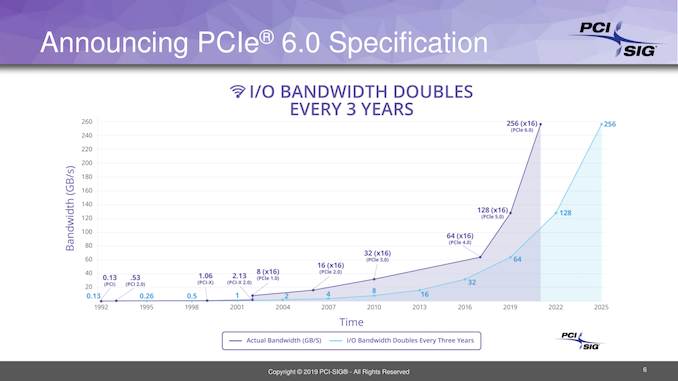PCIe 6.0 Dev Reaches v0.3; On-Track for a Full Specification In 2021
by Ryan Smith on October 15, 2019 10:30 AM EST
Having wrapped up their work on the PCI-Express 5.0 specification earlier this year, the PCI-SIG wasted no time in getting to work on the next version of the specification, PCIe 6.0. That specification, which is expected to be finished in 2021, will once again double PCIe’s bandwidth to 64 GigaTransfers/second – or roughly 128GB/sec (each direction) for a x16 slot – thanks to some high-end encoding technologies like PAM4.
At the time that PCIe 6.0 was first announced, the group was just beginning work on the specification. And now a few scant months later, the group has released a brief update, announcing that they have already completed version 0.3 of the new spec.
The announcement itself is light on technical details, as the design goals and major underlying technologies for PCIe 6.0 were announced at the very start of the project. However the organization is keen to ensure that PCIe development continues moving at a steady pace, to avoid repeating the long gap between 3.0 and 4.0.
And the group’s members will certainly be busy. Even with the 0.3 specification in hand, it’s going to be nearly another two years before the specification is done, reflecting on the fact that there’s a lot of work left to be done to solve the technical challenges in developing PCIe 6.0, and bringing new signaling standards into the specification while maintaining backwards compatibility.
Source: PCI-SIG










45 Comments
View All Comments
CaedenV - Tuesday, October 15, 2019 - link
Not to be a nay sayer on progress... But why this sudden push? My system is pcie 2 and it does not choke my modern high end pcie 3 GPU. New SSDs connect at pcie4 but typical performance is still well within ancient sata3 specs at 40 to 60 MBpsof throughput.Is the point just to have fewer but faster lanes available? Or to use as a cpu core interconnect? Or is there some amazing real world application that truly needs this kind of speed that we just are not hearing about yet?
csutcliff - Tuesday, October 15, 2019 - link
Have you ever used an nvme SSD?GreenReaper - Tuesday, October 15, 2019 - link
Nope. We use SATA, like BillG intended!surt - Tuesday, October 15, 2019 - link
New SSDs connected to pcie4 offer throughput numbers in the 50 00 MB/s range. You were missing two zeros.And those missing two zeros are why people are bothering to keep working on advancing pcie generation by generation.
CaedenV - Wednesday, October 16, 2019 - link
Actually they don't. While they can bench that fast, the real throughput for games, windows, and other non server applications is still well below 100MBps.this is because it is extremely difficult to get an end user application to hit a qd beyond 10which is needed to hit the drives full potentialCajunArson - Tuesday, October 15, 2019 - link
The fact that your system used to browse a few websites gets by in PCIe 2.0 does not mean that nodes in a multi-exaflop supercomputer in 2024-2025* are going to get by fine in PCIe 2.0 either.I might as well say that there's no point in AVX-512 because my smartphone doesn't need it to send a text message.
* which is when PCIe 6.0 will likely be implemented since the hardware doesn't launch anywhere near the date that the specification is finished.
PeachNCream - Tuesday, October 15, 2019 - link
Yes, CaedenV violated the BroGeek Super Secret Code by not seeing the need for more of something, but isn't it a bit of a reach to assume a set of usage criteria? My main gaming box is a passively cooled dual-core Bay Trail laptop with an 11.6 inch screen. Sure it fetches e-mail, but it runs its fair share of games quietly and inexpensively. Gaming on a computer can be fun regardless of the underlying hardware if you are a little bit discerning about system requirements. You certainly can fire up ebay, drop less than $80 on any still working junk laptop, and then run a game to kill a couple or a few thousand hours you just have to be semi-intelligent about it.rpg1966 - Wednesday, October 16, 2019 - link
I think you just assumed a set of usage criteria. Many/most people who play modern games want the most of everything feasible within their budget, i.e. big screens, high frame rates, max detail etc.JanW1 - Wednesday, October 16, 2019 - link
Or this is what the industry will like you to believe. Clearly, there is a difference between professional markets, where interface bandwidth just can't grow fast enough and this is evidently useful, and consumer applications, where it's at this point mostly a matter of consumers being educated to always wanting more (and thus paying for more) than they actually need. Some are starting to understand that learning to have fun with a computer game without maxed-out-everything settings at uselessly-overspecced resolutions may be a more sustainable alternative.rpg1966 - Wednesday, October 16, 2019 - link
What? I'm not arguing that anyone needs PCI 4.0 or 5.0 or whatever. I'm just saying that many/most gamers obviously *want* the biggest/fastest they can get in terms of screen size/resolution/colour depth/brightness/etc, and therefore a GPU (and maybe CPU) to match. Doesn't mean they can afford it.